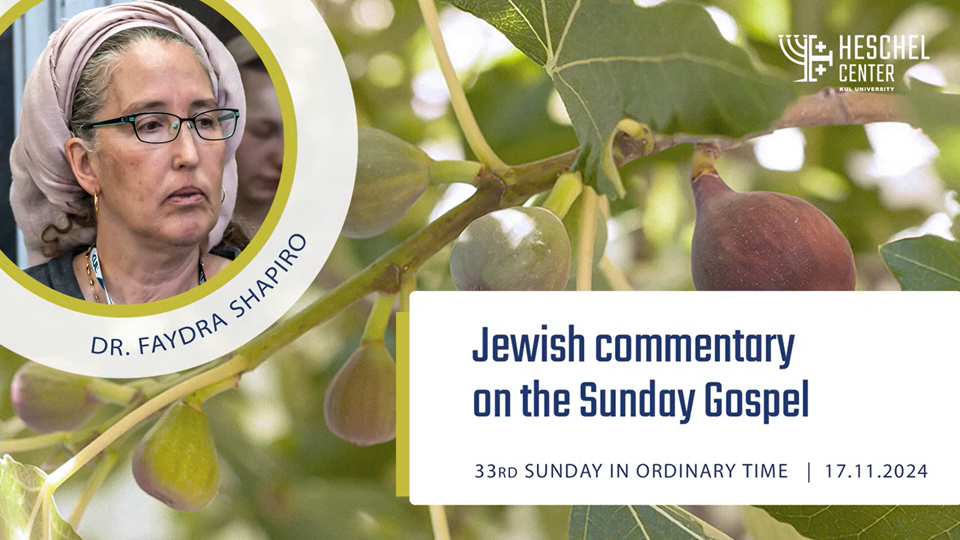“For the earliest hearers of the Gospel, figs, summer, and the End would have already been intimately tied up together in their minds, making this image not just one of “things to come give signs of their approach” but a very powerful, condensed metaphor for the unfolding of time towards God’s judgment“, stresses Dr. Faydra Shapiro, Director of the Israel Center for Jewish-Christian Relations, in her commentary for the Catholic University of Lublin Heschel Center for the Sunday, November 17.
In this Sunday’s Gospel reading we encounter a very rich image, one that occurs in all the synoptics, of the budding fig tree.
“From the fig tree learn its lesson: as soon as its branch becomes tender and puts forth its leaves, you know that summer is near.” – Mk 13, 28
Following this kind of mysterious image, the text continues, making it clear that this is somehow connected to the coming End Times:
“So also, when you see these things taking place, you know that he is near, at the very gates. Truly I tell you, this generation will not pass away until all these things have taken place. Heaven and earth will pass away, but my words will not pass away.” – Mk 12, 29-31.
So why the fig tree image and its leaves? What does it add? Often this is interpreted to to suggest the presence of “signs” – that we can see from specific events (branch becoming tender and leaves coming out) that something is on its way (summer). Which seems reasonable enough. Kind of like “when you see grey clouds in the sky rain is on its way”.
But there’s a lot more at work here. Because for the earliest hearers of the Gospel, the image itself would have immediately summoned up another one from the Hebrew Bible. In Amos chapter 8, 1-2, we have a vision given to the prophet specifically about summer fruit”
“This is what the Lord God showed me: a basket of summer fruit. He said, “Amos, what do you see?” And I said, “A basket of summer fruit.” Then the Lord said to me: “The end has come upon my people Israel.” The word for “summer” (kayits) is closely related to the word for “end” (ketz) that the Lord pronounces for his people.
Thus Mark 13:28 with its budding fig tree, even if not followed up with the clear End Times interpretation in verses 29-31, would have been very clear. Upon hearing about signs of summer’s approach, listeners would have immediately understood that there is something eschatological afoot.
Thus Mark 13:28 with its budding fig tree, even if not followed up with the clear End Times interpretation in verses 29-31, would have been very clear. Upon hearing about signs of summer’s approach, listeners would have immediately understood that there is something eschatological afoot.
But even more interesting, is that the whole thing would not have worked if Jesus had said “learn a lesson from the apple tree”. The specific use of the fig tree matters. The word “summer” in the Hebrew Bible – as we said, related to the word for “end” – is understood specifically to relate to figs. The word summer (kayits) both here and also in Jeremiah 40:10 and in 2 Samuel 16:1 refer clearly to some kind of summer fruit. Bible translators both Jewish and Christian understand this was certainly the fig which is the summer fruit native to the land of Israel, and easy to dry and transport. It is listed in Deuteronomy 8:8 as one of the seven species.
For the earliest hearers of the Gospel, figs, summer, and the End would have already been intimately tied up together in their minds, making this image not just one of “things to come give signs of their approach” but a very powerful, condensed metaphor for the unfolding of time towards God’s judgment.
https://www.youtube.com/watch?v=e_9NDXO3sxE
About the author:
Dr. Faydra Shapiro is a specialist in contemporary Jewish-Christian relations and is the Director of the Israel Center for Jewish-Christian Relations. She received the National Jewish Book Award for her first publication (2006). Her most recent book, with Gavin d’Costa, is Contemporary Catholic Approaches to the People, Land, and State of Israel. Dr. Shapiro is also a Senior Fellow at the Philos Project https://philosproject.org and a Research Fellow at the Center for the Study of Religions at Tel Hai College in Israel.










